This is a TAIL about a RABBIT that became a SQUIRREL and a TIGER that became a MOOSE.
It all started with Joseph Ward Cohen who married Juanita Troplong
Ward and on September 20, 1920 had a son they named Joseph Ward Cohen, Jr.
Joseph "Jay" Ward, Jr. was raised in the progressive community of
Berkeley, California and got his undergraduate diploma from the University of
Berkeley. He moved his education to Harvard to study Real Estate and earned a
Master of Business Administration. In 1943 Jay married Ramona, nicknamed
"Billie", and they would have three children Ron, Carey and Tiffany.
Enough with family background.

Above on the right Jay Ward and on the left the famous face
of "Captain Horatio Magellan Crunch". Known to
"Quaker Oats Company"cereal lovers everywhere. Ward created him and
one can see just a touch of resemblance, but that's not the story I'm telling
here.
Alex Anderson was a boyhood friend of Jay Ward. He was also born and
raised in Berekley, California. The difference was Alex was the nephew of
animator Paul Terry and as he grew up worked for his uncle at "Terrytoons". An animation company known for "Mighty Mouse" and
the talking magpies "Heckle and Jeckle". The future
animator learned his trade well from his Uncle Paul.

Above Alex Anderson at work.
THE COMIC STRIPS OF TELEVISION
Do you recognize this person?

In 1947 Alex went to Uncle Paul Terry with an idea for the new medium of television. He wanted
"Terrytoons" to make cartoons to be shown on one of the networks at the time: Dumont, CBS, ABC and NBC. Uncle Paul told Alex the animation studio would stick with cartoons for motion picture theaters.
Anderson next attempted to sell his idea to the television stations directly, but without success. Feeling dejected, but still believing in his concept. Alex Anderson looked up his childhood friend Jay Ward and pitched his idea. The result was the creation of "Television Arts Production" in 1947. The partnership had Alex in charge of Production and Jay as the company's Business Manager.
The two friends now attempted to sell their series which consisted of three of Alex's
creations "Crusader Rabbit", "Dudley Do-Right of the
Mounties", seen above, and "Hamhock Jones", below.

"Hamhock", obviously a parody of "Sherlock Holmes" fights his arch enemy a Siamese twin. The problem is one twin is good and the other the evil mastermind, but which is which?
As of this writing the original five minute and twenty second "Dudley Do-Right" pilot, a parody of the 1939 Jeanette Mac Donald and Nelson Eddy operetta motion picture "Rose Marie", can be found on YouTube at:

In 1947 Alex went to Uncle Paul Terry with an idea for the new medium of television. He wanted
"Terrytoons" to make cartoons to be shown on one of the networks at the time: Dumont, CBS, ABC and NBC. Uncle Paul told Alex the animation studio would stick with cartoons for motion picture theaters.
Anderson next attempted to sell his idea to the television stations directly, but without success. Feeling dejected, but still believing in his concept. Alex Anderson looked up his childhood friend Jay Ward and pitched his idea. The result was the creation of "Television Arts Production" in 1947. The partnership had Alex in charge of Production and Jay as the company's Business Manager.

"Hamhock", obviously a parody of "Sherlock Holmes" fights his arch enemy a Siamese twin. The problem is one twin is good and the other the evil mastermind, but which is which?
As of this writing the original five minute and twenty second "Dudley Do-Right" pilot, a parody of the 1939 Jeanette Mac Donald and Nelson Eddy operetta motion picture "Rose Marie", can be found on YouTube at:
A few stills from that original "Dudley Do-Right".

Above the original "Dudley". Below instead of "Snidely Whiplash" the villain was "Sydney 'The Snake' Snodgrass".

Below instead of "Nell Fenwick" the heroine was "Bess Blushmore".

Jay Ward started making the rounds and at NBC meet with Gerald Bertram "Jerry" Fairbanks, five time nominated and twice Oscar Winner, one of the networks "Supervising Producers".

While the NBC Executives were
against the idea of what was being called "The Comic Strips of
Television" and especially the character of "Crusader
Rabbit". Jerry Fairbanks thought otherwise and was able to sell them on
syndicating just "Crusader Rabbit".
CRUSADER RABBIT

The series was test marketed between late 1947 into early 1948. This group of cartoons had very limited animation depending upon a narrator to move the plot along. In fact you might call them and the first season of the show "Animated Storyboards". Also, as a marketing tool, there were one panel strips in local newspapers introducing the character to kids with a safety theme.



Every hero must have a faithful
companion at their side. "The Long Ranger" had
"Tonto", "The Cisco Kid" had
"Pancho", "The Adventures of Wild Bill Hickok" had
"Jingles". Such were the rules for 1950's Children's television and
so "Crusader Rabbit" had "Ragland T.
Tiger" aka: "Rags".


"Crusader Rabbit" was a "Don Quixote" rabbit and
"Rags" was his "Sancho Panza" companion. The image below
shows "Don Quixote" the "Knight and Crusader" with "Sancho". "Quixote" determined to
stop evil wherever he finds it. He also reflects upon the look of
"Crusader Rabbit" in the title sequence.

The name "Ragland T. Tiger" comes from the Jazz song "Tiger Rag" and the "T" stands for the word "The". So, he's really "Ragland The Tiger". Additionally, "Crusader Rabbit" and "Rags" live in the community of "Galahad Glenn" referencing "Sir Galahad" from "King Arthur".

Jerry Fairbanks hired
composer Clarence E, Wheeler to write the needed opening and closing music.
Wheeler had written the music for George Pal's "Puppetoons", several
"B" movies, and would go on to write for Walter Lantz and
his character "Woody Woodpecker".

Clarence Wheeler rearranged the children's song "Ten Little Indians" into "Main Title Rabbit" and rearranged the American Folk Song
"The Trail to Mexico" into "Rabbit
Fanfare" for the closing.
On August 1, 1950, two months
before my fourth birthday, "Crusader Rabbit" premiered
on WNBC in New York and KNBH (KNBC) :Los Angeles, historically becoming the first
made directly for television animated series.

A person can get confused by the
therm "Episode" and many have, because "Episode" has been
used to describe each different story line by some and each part of that story line by others.
So, "CRUSADER RABBIT VS THE STATE OF TEXAS" is both mentioned as being "Episode One" of "Season One" and having "15 Episodes" in it. In short this is the first story line used and was divided into 15 Chapters. Each chapter ran just over 4 minutes and had a cliff hanger ending.
So, "CRUSADER RABBIT VS THE STATE OF TEXAS" is both mentioned as being "Episode One" of "Season One" and having "15 Episodes" in it. In short this is the first story line used and was divided into 15 Chapters. Each chapter ran just over 4 minutes and had a cliff hanger ending.
The "Hare With a Punch"
was made in glorious black and white to be seen on our glorious 17 inch, or
smaller, black and white television screens. Although both "The
Lone Ranger" and "The Cisco Kid" and
some other programs were actually shot in color. However, like most 1950's programming the budget made color inadvisable.
The first actual color "commercially broadcast" television show wasn't until nine years after the premier of "Crusader Rabbit" on September 12, 1959. This was the first episode of the new Western series "Bonanza". Which was also seen on NBC owned by the "Radio Corporation of America (RCA)". That was selling the first color 21 inch sets to families at $500 and needed televised product.
The first actual color "commercially broadcast" television show wasn't until nine years after the premier of "Crusader Rabbit" on September 12, 1959. This was the first episode of the new Western series "Bonanza". Which was also seen on NBC owned by the "Radio Corporation of America (RCA)". That was selling the first color 21 inch sets to families at $500 and needed televised product.
Right after the opening title sequence
for an episode of "Crusader Rabbit", I described above, came an
overlay saying:
A TELEVISION ARTS CARTOON
Produced by Jerry Fairbanks, Inc.
At then end of the episode the
viewer saw at title card reading:
WATCH FOR ANOTHER EPISODE OF
CRUSADER RABBIT
OVER THIS STATION
At no time are the names Jay Ward,
or Alex Anderson ever mentioned.
The Original Series ran from 1950 through 1952. It contained, by my definition, 10 Story Lines divided
into as little as 10 black and white Chapters and as many as 30 for a total of
195. Here's the list of those Story Lines:
1950
Crusader vs. the
State of Texas (15 chapters)
Crusader vs. the
Pirates (20 chapters\
Crusader and the Rajah of Rinsewater (20 chapters)
Crusader and the Rajah of Rinsewater (20 chapters)
Crusader and the
Schmohawk Indians (15 chapters)
Crusader and the
Great Horse Mystery (20 chapters)
1951
1951
Crusader and the
Circus (10 chapters)
Crusader in the
Tenth Century (30 chapters)
1952
1952
Crusader and the
Mad Hollywood Scientist (15 chapters)
Crusader and the
Leprechauns (25 chapters)
Crusader and the
Showboat (25 chapters)


The initial black and white
animation was done by Alex Anderson in his garage located at 2727 Stuart
Street, Berkeley, California.
All heroes have an enemy and the
main one in the Original Series was "Dudley Nightshade". A parody of the poisonous plant called "Deadly Nightshade (Atropa belladonna)".
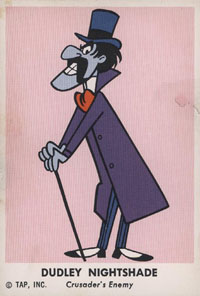
Another character has a familiar
sounding name to fans of "Rocket J. Squirrel" and
that was "Whetstone Whiplash". However, I could not locate a picture
of him.
These 195 Chapters needed somebody
to come up with the ideas and the characters. That was primarily Alex Anderson.
The main writing credit went to Alex for all ten from 1950 through 1952 and
Jay Ward for nine. However, there were four other writers between 1950 and
1951.
Lloyd Turner worked on five of the
ten. Turner also worked on Bob Clampett's "Time for
Beany", would write for "Rocky and Friends",
"Get Smart", "The Partridge Family", "Mork and
Mindy" and others. Lloyd Turner was one of the animators on the
Warner Brother's "Looney Toons" during the
1940's.
Hal Goodman started with "Crusader
Rabbit", but moved to television comedy writing for
such personalities as "Jackie Gleason", "Red
Skelton", "Steve Allen", "Frank Sinatra" and "Johnny
Carson".
Jack Miller worked on only two of
the original series, but would return for thirteen of the second series. He had
been working on "Looney Toons" since 1937 and would
end his writing and animation career with twenty-two adventures on 1973's "Star
Trek: The Animated Series".
I could not find any
information of Arthur North other than the two stories for "Crusader
Rabbit".
Once the cartoons were drawn Jay,
Alex and producer Jerry needed voices.
The original voice for
"Crusader Rabbit" between 1950 and 1952 was Lucille Bliss. While most
of my readers may not have seen a single Chapter of this series. They may be
familiar with Walt Disney's 1950 animated classic "Cinderella" and
if so have heard her voice. Lucille Bliss' second voice role was that of the
Step Sister "Anastasia". Bliss would be heard in
Disney's "Peter Pan" and "101
Dalmatians". Her other voice roles included "The
Flintstones", Ralph Baskshi's 1978 "Lord of the
Rings" and was "Smurfette" on the original "The
Smurf's" television series.

Vern Loudan provided the voice for
"Ragland T. Tiger". I could not locate a photo. He started his career
in 1937 on an NBC radio station located in San Francisco, California. In 1950
he became a producer, director and announcer on KRON-TV in the Bay area. Some
of his freelance work included all 23 "Crusader Rabbit" stories as
"Rags". He became the NBC, became of the time zones, West Coast
director of the "Today Show" and "The Huntley-Brinkley
Report".
Roy Whaley was the narrator for all 195 Chapters of "Crusader Rabbit". Along with the "The
Comic Strips of Television" presentation to the NBC executives.
Whaley would appears in an episode of four other television shows as an actor.
Russ Coughlian also supplied voices for "Dudley Nightshade", "Brutus", "Captain
Jolly Rodger" and some others for both series. He was a local Bay Area
radio announcer who had help form the "Arm Forces Radio Network"
during World War 2. He became the sales manager and a talk show host on San
Francisco's ABC affiliate KGO-TV.
As to the plots for the Story Lines. There was a little twisted fun in them that parents
discovered, but went over their kid's heads. This might be reflected in the art
work, or with puns and references to familiar events going on across the country and reported on the news.
The following are some of the scenes
from the very first adventure. "Crusader Rabbit vs the State
of Texas". In which "Crusader" and
"Rags" enter "Cactus Junction, Texas".




The "Hollywood
Freeway" was a target of comedians including Bob Hope and the
writers for "Crusader Rabbit". The freeway was officially approved by
Los Angeles voters in 1924 as a "Stop-Free Express Highway"and
construction began, but because of the "Hollywood Hills" that it must
pass through. The first section wasn't completed until June 15, 1940 and, then,
was only one mile and a half paralleling Cahuenga Boulevard. The main segment
connecting the growing San Fernando Valley to downtown Los Angeles was not
finished until April 16, 1954, or two years after the end of the Original
"Crusader Rabbit Series". By that time the "Stop-Free Express
Highway" of 1924 was the parking lot of 1954 and had been the target of
throw away jokes by "Rags" and Bob Hope nationally.
Another example of the writers sense
of humor happened within a covered wagon train being protected by
"Crusader" and "Rags". Most movies about settler Wagon
Trains have them crossing the country for either Oregon, or California.
However, in one chapter of "Crusader and the Schmohawk Indians". The viewer sees a Covered Wagon having written on its side:
AZUSA OR BUST
This was a reference to a popular
joke American's were very familiar with from the "Jack Benny Radio
Program". Mel Blanc had been heard on the show since the mid-1930's. He
had a recurring routine mentioning three California towns most people in the
United States had never visited, or were aware existed. These were located in
the rural countryside outside of downtown Los Angeles. In the recurring skit
Blanc was a train conductor who always said:
TRAIN LEAVING ON TRACK FIVE FOR ANAHEIM, AZUSA AND CUCAMONGA!
In 1950 the rural farming community
of Azusa had a population of 11,042. Rural Anaheim in 1955, became the
location of Disneyland and had to be reached by a two lane road. Cucamonga was
even harder to reach and had less of a 1950 population than Azusa. Today if you travel on the freeway system from downtown Los Angeles. You can reach the sign for the City of Azusa in 12 minutes, but blink and you've past Azusa.
Jerry Fairbanks created merchandise to sell to the kids watching and a club. I was a member.

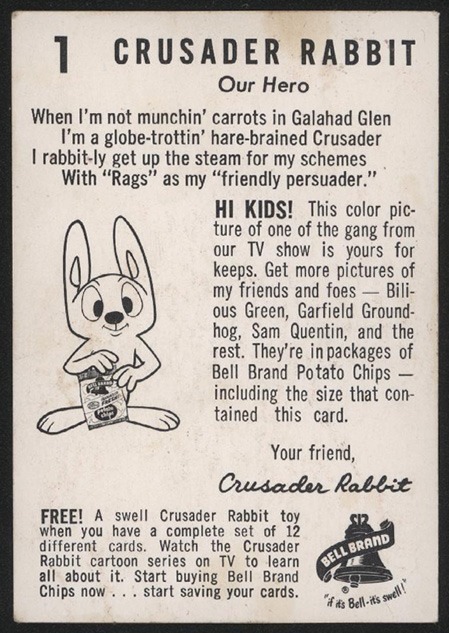

As of this writing you can watch the Original "Crusader
Rabbit" at:
https://video.search.yahoo.com/search/video;_ylt=AwrS_AnzQ0BdNUgA8D9XNyoA;_ylu=X3oDMTByZDNzZTI1BGNvbG8DZ3ExBHBvcwMyBHZ0aWQDBHNlYwNzYw--?p=crusader+rabbit&fr=mcafee#id=39&vid=7fb892eb54039d8705fa75d07d86f296&action=view
https://video.search.yahoo.com/search/video;_ylt=AwrS_AnzQ0BdNUgA8D9XNyoA;_ylu=X3oDMTByZDNzZTI1BGNvbG8DZ3ExBHBvcwMyBHZ0aWQDBHNlYwNzYw--?p=crusader+rabbit&fr=mcafee#id=39&vid=7fb892eb54039d8705fa75d07d86f296&action=view
The Original "Crusader
Rabbit" created by Jay Ward and Alex Anderson, as I said, ended in 1952.
"Television Arts Production" was purchased by Producer
Shull Bronsall's "Capital Enterprises".
As a result of the purchase Bonsall
claimed he now owned the character of "Crusader Rabbit". Jay Ward,
Alexander Anderson, Jerry Fairbanks and NBC took Shull Bonsall to court
and LOST.
In 1956 Bonsall's "Crusader Rabbit" was ready for airing in color. Note the "CR" on the shield.
In 1956 Bonsall's "Crusader Rabbit" was ready for airing in color. Note the "CR" on the shield.

The new series contained thirteen
stories written by Barbara Chain and Chris Hayward. The titles were full of
puns.
The Great Uranium Hunt aka: Mine Your Own Business
The Yukon Adventure aka: Thar's Gold in Them Fills
Tales of Schmerwood Forest Crooks Tour
West We Forget
Sahara You
Guillible's Travels
Should Auld Acquaintances Be for Cotton aka: Belly Acres Mystery
Nothing Atoll
Scars and Strips
Apes of Wrath
Caesar's Salad aka: No Place Like Rome
The Great Baseball Mystery aka: Gone With the Wind-Up
The Search for the Missing Link
The series initially went into syndication in 1956, but before the year was up. Shull Bonsall had pulled it and placed it on the shelf until 1959. When it would return for obvious reasons.
Also in 1956 Dell Publishing issued just two "Crusader Rabbit" comic books.
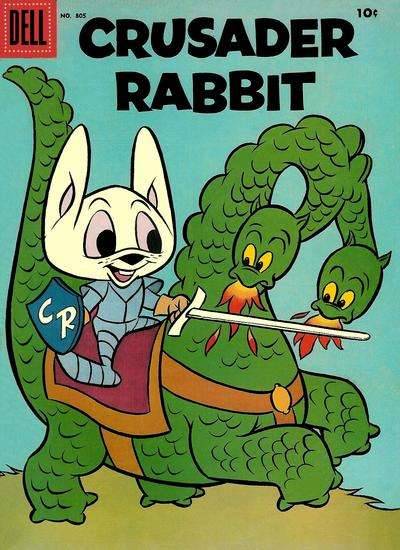
Shull Bonsall knew the value of merchandising. Even if items came out for only one year 1956. Two examples of Bonsall's merchandising follow.


THE FROSTBITE FALLS REVIEW
The Great Uranium Hunt aka: Mine Your Own Business
The Yukon Adventure aka: Thar's Gold in Them Fills
Tales of Schmerwood Forest Crooks Tour
West We Forget
Sahara You
Guillible's Travels
Should Auld Acquaintances Be for Cotton aka: Belly Acres Mystery
Nothing Atoll
Scars and Strips
Apes of Wrath
Caesar's Salad aka: No Place Like Rome
The Great Baseball Mystery aka: Gone With the Wind-Up
The Search for the Missing Link
The series initially went into syndication in 1956, but before the year was up. Shull Bonsall had pulled it and placed it on the shelf until 1959. When it would return for obvious reasons.
Also in 1956 Dell Publishing issued just two "Crusader Rabbit" comic books.

Shull Bonsall knew the value of merchandising. Even if items came out for only one year 1956. Two examples of Bonsall's merchandising follow.


THE FROSTBITE FALLS REVIEW
Another of Alex Anderson's unsold
ideas had been a cartoon show set in a television station in the Northwest. He
called it "The Frostbite Falls Review". Jay and Alex
now took a look at bringing the show to the television screen.
The cast of characters included:
Rocket "Rocky"
Squirrel, Oski Bear, Canadian Bullwinkle Moose, Sylvester Fox, Blackstone Crow
and Floral Fauna.
As with the characters in "Crusader
Rabbit". The concept and characters were all created by Alex
Anderson. The name "Bullwinkle" actually came for a car dealership in
Berkeley called "Bullwinkel Motors". All Anderson did was transpose
the last two letters.
A problem immediately arose over were
the show was to be produced. Jay Ward now lived in Los Angeles and he wanted it
made there, but Alex Anderson still lived in Berkeley and, like "Crusader
Rabbit", wanted it produced there. In the end Jay won and hired Bill
Scott as Head Writer and co-Producer. Alex was out by his own choice.
Chris Hayward, who had co-written Shull Bonstall's "Crusader Rabbit", was hired to co-write what was still "The Frostbite Falls Review". Only two of the original characters moved into the spotlight of the new series.
The character of "Crusader Rabbit" had morphed into now "Rocket J. Squirrel". While "Ragland T. Tiger" had morphed into "Bullwinkle J. Moose". Although the characters were different animals with different names. They were substantially the two original characters created by Alex Anderson and seen on NBC between 1950 and 1952. As for the two heroes now having the same middle initial of "J". Just spell it out as "Jay" and it stood for producer Jay Ward.
On November 19, 1959 that first program, from "Jay Ward Productions", aired on ABC. It was now entitled:

In that original first season of "Rocky and His Friends". Each show opens and closes with the next part of the current story arc featuring our two heroes. As these were cliff hanger story lines. Each Chapter ends with the narrator giving a comic one liner teaser for the next Chapter. The middle of the individual program would be filled with a selection of cartoons featuring other characters.
A single program might include "Fractured Fairy Tales", "Peabody's Improbable History", "Aesop and Son"."Bullwinkle's Corner", "The World of Commander McBragg", "Mr. Know It All" and least we forget. Finally the on small screen appearance of Alex Anderson's "Dudley Do-Right of the Mounties".
"Rocky and His Friends" only ran from 1959 into 1960 for 28 programs of 23 minutes each.
Although the animation was in color. ABC, who ran the show, had yet to convert to "commercial color broadcasting". In fact the only network with color was still NBC during those 28 programs run.
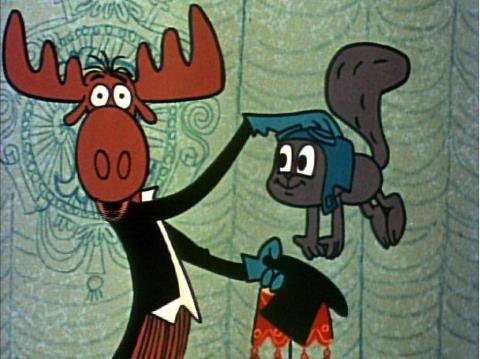
Above "Bullwinkle" pulls "Rocky" out of a hat in the opening sequence for "Rocky and His Friends".
Chris Hayward, who had co-written Shull Bonstall's "Crusader Rabbit", was hired to co-write what was still "The Frostbite Falls Review". Only two of the original characters moved into the spotlight of the new series.
The character of "Crusader Rabbit" had morphed into now "Rocket J. Squirrel". While "Ragland T. Tiger" had morphed into "Bullwinkle J. Moose". Although the characters were different animals with different names. They were substantially the two original characters created by Alex Anderson and seen on NBC between 1950 and 1952. As for the two heroes now having the same middle initial of "J". Just spell it out as "Jay" and it stood for producer Jay Ward.
On November 19, 1959 that first program, from "Jay Ward Productions", aired on ABC. It was now entitled:

In that original first season of "Rocky and His Friends". Each show opens and closes with the next part of the current story arc featuring our two heroes. As these were cliff hanger story lines. Each Chapter ends with the narrator giving a comic one liner teaser for the next Chapter. The middle of the individual program would be filled with a selection of cartoons featuring other characters.
A single program might include "Fractured Fairy Tales", "Peabody's Improbable History", "Aesop and Son"."Bullwinkle's Corner", "The World of Commander McBragg", "Mr. Know It All" and least we forget. Finally the on small screen appearance of Alex Anderson's "Dudley Do-Right of the Mounties".
"Rocky and His Friends" only ran from 1959 into 1960 for 28 programs of 23 minutes each.
Although the animation was in color. ABC, who ran the show, had yet to convert to "commercial color broadcasting". In fact the only network with color was still NBC during those 28 programs run.

Above "Bullwinkle" pulls "Rocky" out of a hat in the opening sequence for "Rocky and His Friends".
Below "Mr. Peabody and His Pet Boy Sherman" in front of the "Way Back Machine".

Above one of the many title cards for "Aesop and Son". Below it's "Bullwinkle's Corner" attempting the nursery rhyme "Hickory, Dickory Dock".


Above "The World of Commander Mc Bragg". Below "Mr. Know It All".

Below "Dudley Do-Right of the Mounties" in his new updated look. Left to right "Snidely Whiplash", "Dudley", "Nell" and "Horse".

When "Rocky and His Friends" left ABC for NBC there was a name change. On NBC from 1961 to 1964 the title dropped "Rocky" altogether and became "The Bullwinkle Show",
After 1964 the show went into syndication and the name kept changing. A viewer might be watching "The Rocky Show", "The Rocky and Bullwinkle Show", "The Adventures of Rocky and Bullwinkle" and the reverse as "The Adventures of Bullwinkle and Rocky". Because of being in syndication there were actual times when the show played opposite itself in a community under two different names. In all "Jay Ward Productions" made 163 of those 23 minute programs.
As to being in syndication, which ran as late as 2016, there is a little bit of confusion. So here goes.
Underlying rights to the series are owned by "Universal Studios". However, during its initial run between 1959 and 1964 "General Mills" was the main sponsor and the cereal company retained syndication rights.
The following are stills from some of the "General Mills Commercials" on the original black and white ABC "Rocky and His Friends".



Later "Rocky and Bullwinkle" showed up in the Sunday Comic Sections of local newspapers.



Additionally the syndication package might not look like either the original ABC, or NBC broadcast program and is another reason for those many name changes. "General Mills" had control of two of these syndication packages and still retains some of the rights to them.
For example the "General Mills" syndicated package under the name "The Bullwinkle Show". Consists of the first 78 "Rocky and Bullwinkle" stories from the first two seasons of "Rocky and His Friends". The other segments such as "Fractured Fairy Tales", "Dudley Do-Right" and "Mr. Peabody" sometimes are out of order from the original broadcast appearances of each title.
The final 20 shows of the syndicated "The Bullwinkle Show" contained "Rocky and Bullwinkle" stories not in the original televised "The Bullwinkle Show". Got it? The reason many get confused talking about a certain program. The second "General Mills" package is even more confusing, but reader gets the idea of what was happening in syndication.
Another example of mixing the program content was seen on "Nickelodeon". The program was called "Bullwinkle's Moose-O-Rama" and except for running the "Rocky and Bullwinkle" story arcs. Everything else in a single program was a hodgepodge of the other features. Sometimes, for example, running multiple "Dudley Do-Rights", or "Mr. Peabody's". One after the other between the two "Rocky and Bullwinkle" Chapters. As "Nickelodeon's" target audience probably had no idea of what the original shows looked like.
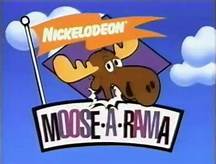
When Alex Anderson created the town of "Frostbite Falls, Minnesota". He was thinking of the community of "International Falls, Minnesota".

"International Falls" is located on the Rainy River directly opposite "Fort Francis" in Ontario, Canada and is connected by a bridge. The original nickname of the town was the "Icebox of the Nation", but after the series had played, also became known as "Frostbite Falls". The average temperature 109 days out of the year is below 32 degrees. As of the 2010 census the population was 6,424.
A debate can be made over who's the most famous character other than "Rocket J. Squirrel" and "Bulkwinkle J. Moose", but here's a look at two that always come up.
I give you "Rocky and Bullwinkle's" number one enemies, spying for "Pottsylannia", "Boris Badenov" and "Natasha Fatale".
The character of "Boris Badenov" is a combination of many elements and was created by writer Bill Scott. Scott also voiced "Bullwinkle" and would write for the original animated adventures of "Alvin and the Chipmunks", "The Wuzzles" and "The Adventures of the Gummi Bears".

The name "Boris Badenov" was a pun on the 16th Century "Tsar Boris Godonov".

His accent and explosive temper was based upon actor Akim Tamiroff in director Preston Sturges' 1940 motion picture "The Great McGinty".

"Boris'" appearance was based upon the Charles Addams character "Gomez Addams".
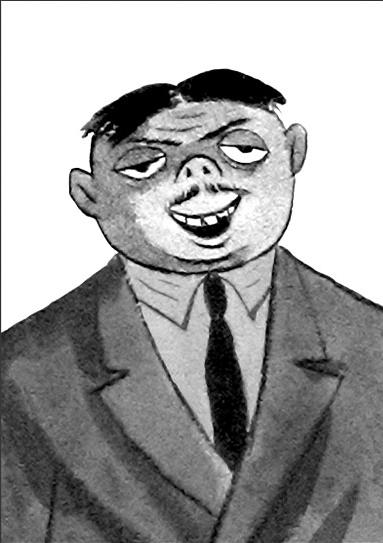

The character of "Natasha Fatale's" last name is of course a pun on "Femme Fatle". However, she is always referred too in the series as only "Natasha".
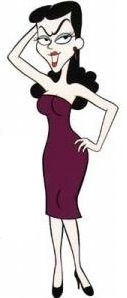

"Boris" and "Natasha" work for "Fearless Leader". Who actually had a boss only seen in two stories "Upisdaisium" and "Metal Munching Moon Mice" known as "MR. BIG"!
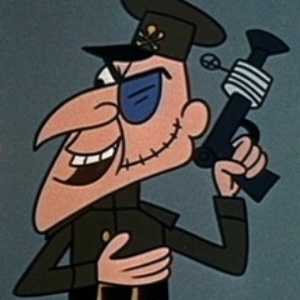
"Fearless Leaders" is a parody of German born actor and director Eric von Stroheim with a stereo typical Nazi look to his face..

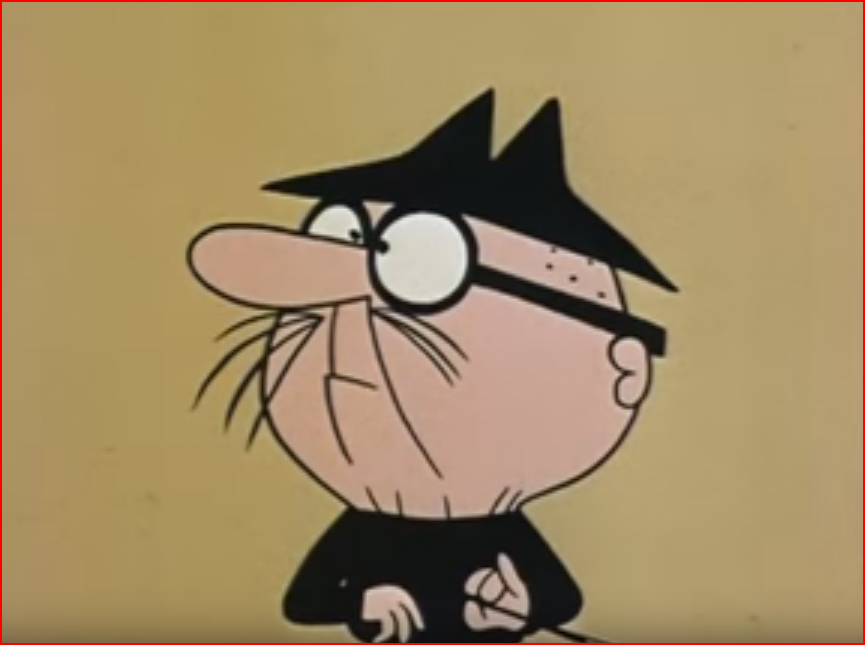
Above the very small "Mr. Big".
JET FUEL FORMULA
"Rocky and His Friends" first season contained 20 programs. Those programs actually formed the longest story arc in the entire series called the "Jet Fuel Formula". Which was the title of the first Chapter and the first official appearance of "Rocky" and "Bullwinkle" on November 19, 1959.
That first "Rocky and His Friends" program contained five parts.
1. Jet Fuel Formula (Rocky and Bullwinkle)
2. Fractured Fairy Tale: Rapunzel
3. Bullwinkle's Corner: "The Swing" by Robert Lewis Stevenson
4. Peabody's Improbable History: Show Opening
5. Bullwinkle's Ride, or Goodbye Dollink
Lets look at parts of that opening opening Chapter "Jet Fuel Formula". Which started a story arc attacking America's fears of the Cold War and set the tone for both the puns and political satire of the entire series.
Scientists discover a Rocketship heading for the Earth from the Moon..


As the Rocketship nears the Earth. Television News Reporter "Dorson Bells" attempts to calm the population by telling everyone this is NOT A PLAY. As the puns first begin with a reference to Orson Wells' "War of the Worlds" broadcast that caused panic on Halloween 1939.

The Rocketship crashes and as the Military and Government representatives look on. The hatch opens and out comes "Rocky" and "Bullwinkle". Who proceed to explain they're not from the Moon, but "Frostbite Falls, Minnesota". Apparently something happened when "Bullwinkle" was making his Grandmother's "Mooseberry Fudge" cake and it blew the two to the moon.
Our Government wants the "Cake Recipe" aka: the "Jet Fuel Formula". However, only the amounts of the ingredients remain and not the ingredients themselves on "Bullwinkle's" recipe sheet"

Meanwhile, the totalitarian state of "Pottsylvania's". "Fearless Leader" sends "Boris" and "Natasha" to get the formula. Next two Moon Men, "Gidney" and "Cloyd", arrive on Earth. Not as a vanguard of an invasion force as the Government thinks, but to stop the Earth from creating a "Tourist Invasion" of the Moon.
Later in the story arc, "Peter 'Wrongway' Peachfuzz", the Captain of the "S.S. Andalusia" enter the story.
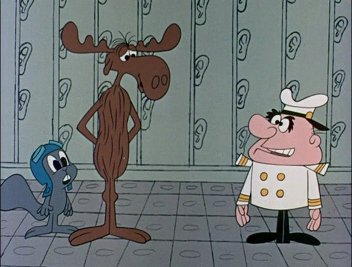
For those interested in the entire first program. You can find it, as of this writing, at:
https://video.search.yahoo.com/search/video;_ylt=Awr9Ik1b_kJdKE8ANKxXNyoA;_ylu=X3oDMTByZDNzZTI1BGNvbG8DZ3ExBHBvcwMyBHZ0aWQDBHNlYwNzYw--?p=rocky+and+bullwinkle+jet+fuel&fr=mcafee#id=1&vid=94c273444e6bc913f8ef460a5d3ef19a&action=view
I just want to mention two characters "Edgar and Chauncey". The are two old men who appear in many of "Rocky" and "Bullwinkle's" adventures. They sit on a park bench and make comments about what's going on. They predate Jim Henson's "Muppet" two old men in the balcony by 17 years.

Then there was the merchandise that still goes on as of this writing. Here's a very small sample.

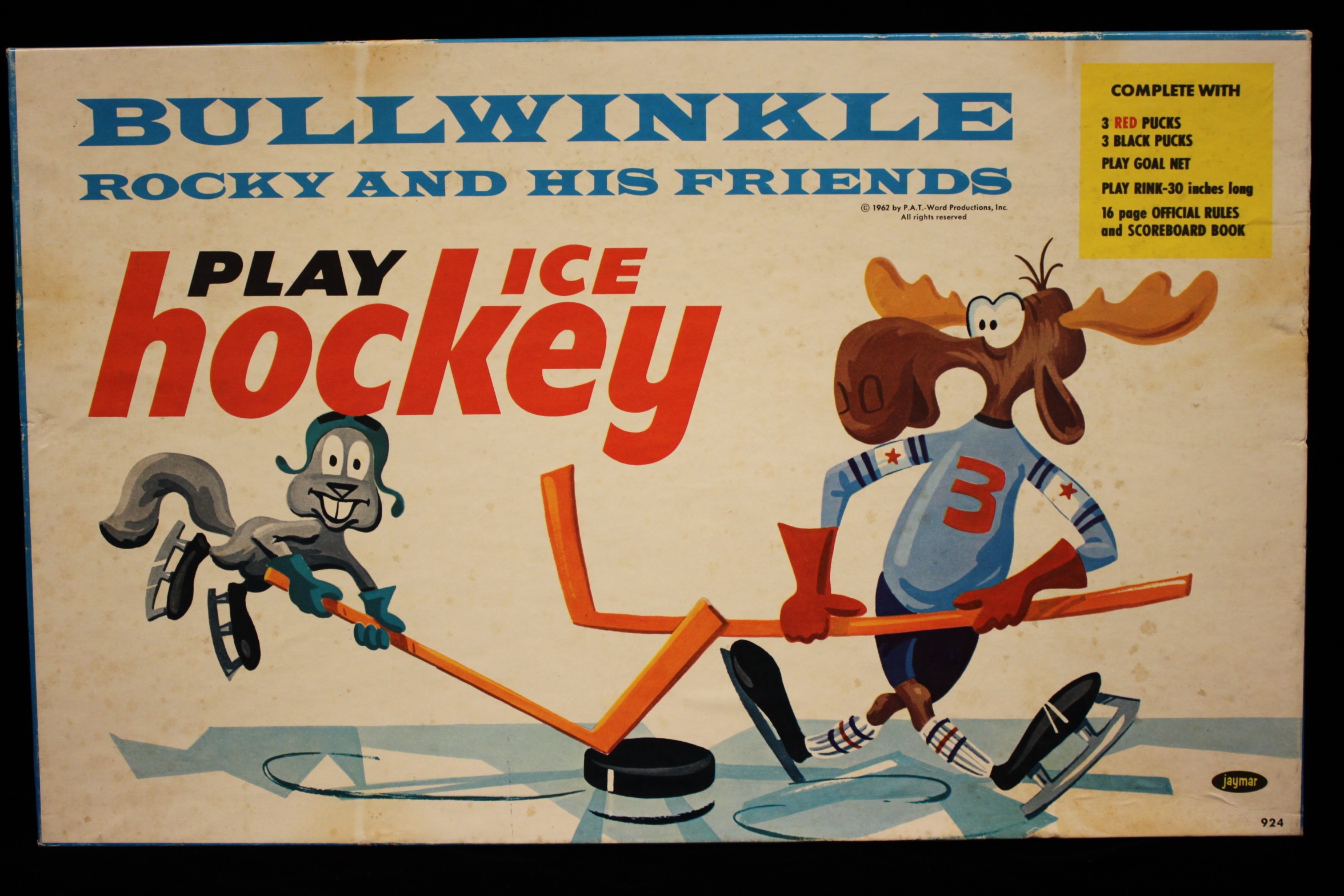

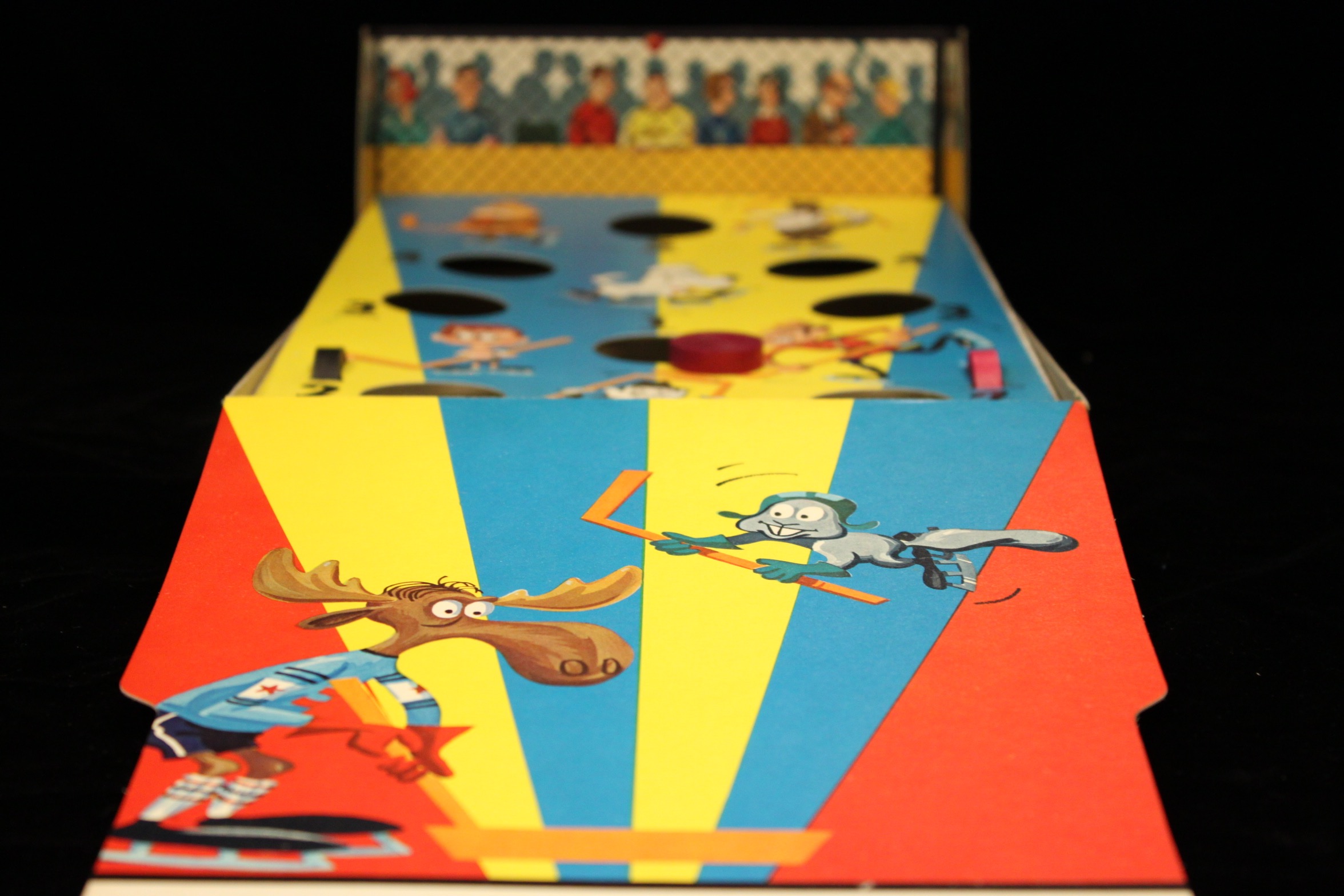
On October 12, 1989 in Hollywood, California, Jay Ward passed away from cancer. Not all things were fun and games in the "Crusader Rabbit" and "Rocky and Bullwinkle" story. After the passing of Jay Ward, Alexander Anderson discovered that Jay had copyrighted the characters of "Dudley Do-Right", "Rocky" and "Bullwinkle" entirely in his name as creator. Alex sued the heirs of Jay Ward for the credit of creating those three characters. He would win a financial award from the court and recognition that it was Alex and not Jay who created the original characters.


Above "The World of Commander Mc Bragg". Below "Mr. Know It All".

Below "Dudley Do-Right of the Mounties" in his new updated look. Left to right "Snidely Whiplash", "Dudley", "Nell" and "Horse".

When "Rocky and His Friends" left ABC for NBC there was a name change. On NBC from 1961 to 1964 the title dropped "Rocky" altogether and became "The Bullwinkle Show",
After 1964 the show went into syndication and the name kept changing. A viewer might be watching "The Rocky Show", "The Rocky and Bullwinkle Show", "The Adventures of Rocky and Bullwinkle" and the reverse as "The Adventures of Bullwinkle and Rocky". Because of being in syndication there were actual times when the show played opposite itself in a community under two different names. In all "Jay Ward Productions" made 163 of those 23 minute programs.
As to being in syndication, which ran as late as 2016, there is a little bit of confusion. So here goes.
Underlying rights to the series are owned by "Universal Studios". However, during its initial run between 1959 and 1964 "General Mills" was the main sponsor and the cereal company retained syndication rights.
The following are stills from some of the "General Mills Commercials" on the original black and white ABC "Rocky and His Friends".



Later "Rocky and Bullwinkle" showed up in the Sunday Comic Sections of local newspapers.



Additionally the syndication package might not look like either the original ABC, or NBC broadcast program and is another reason for those many name changes. "General Mills" had control of two of these syndication packages and still retains some of the rights to them.
For example the "General Mills" syndicated package under the name "The Bullwinkle Show". Consists of the first 78 "Rocky and Bullwinkle" stories from the first two seasons of "Rocky and His Friends". The other segments such as "Fractured Fairy Tales", "Dudley Do-Right" and "Mr. Peabody" sometimes are out of order from the original broadcast appearances of each title.
The final 20 shows of the syndicated "The Bullwinkle Show" contained "Rocky and Bullwinkle" stories not in the original televised "The Bullwinkle Show". Got it? The reason many get confused talking about a certain program. The second "General Mills" package is even more confusing, but reader gets the idea of what was happening in syndication.
Another example of mixing the program content was seen on "Nickelodeon". The program was called "Bullwinkle's Moose-O-Rama" and except for running the "Rocky and Bullwinkle" story arcs. Everything else in a single program was a hodgepodge of the other features. Sometimes, for example, running multiple "Dudley Do-Rights", or "Mr. Peabody's". One after the other between the two "Rocky and Bullwinkle" Chapters. As "Nickelodeon's" target audience probably had no idea of what the original shows looked like.
When Alex Anderson created the town of "Frostbite Falls, Minnesota". He was thinking of the community of "International Falls, Minnesota".

"International Falls" is located on the Rainy River directly opposite "Fort Francis" in Ontario, Canada and is connected by a bridge. The original nickname of the town was the "Icebox of the Nation", but after the series had played, also became known as "Frostbite Falls". The average temperature 109 days out of the year is below 32 degrees. As of the 2010 census the population was 6,424.
A debate can be made over who's the most famous character other than "Rocket J. Squirrel" and "Bulkwinkle J. Moose", but here's a look at two that always come up.
I give you "Rocky and Bullwinkle's" number one enemies, spying for "Pottsylannia", "Boris Badenov" and "Natasha Fatale".
The character of "Boris Badenov" is a combination of many elements and was created by writer Bill Scott. Scott also voiced "Bullwinkle" and would write for the original animated adventures of "Alvin and the Chipmunks", "The Wuzzles" and "The Adventures of the Gummi Bears".

The name "Boris Badenov" was a pun on the 16th Century "Tsar Boris Godonov".

His accent and explosive temper was based upon actor Akim Tamiroff in director Preston Sturges' 1940 motion picture "The Great McGinty".

"Boris'" appearance was based upon the Charles Addams character "Gomez Addams".


The character of "Natasha Fatale's" last name is of course a pun on "Femme Fatle". However, she is always referred too in the series as only "Natasha".


"Boris" and "Natasha" work for "Fearless Leader". Who actually had a boss only seen in two stories "Upisdaisium" and "Metal Munching Moon Mice" known as "MR. BIG"!

"Fearless Leaders" is a parody of German born actor and director Eric von Stroheim with a stereo typical Nazi look to his face..


Above the very small "Mr. Big".
JET FUEL FORMULA
"Rocky and His Friends" first season contained 20 programs. Those programs actually formed the longest story arc in the entire series called the "Jet Fuel Formula". Which was the title of the first Chapter and the first official appearance of "Rocky" and "Bullwinkle" on November 19, 1959.
That first "Rocky and His Friends" program contained five parts.
1. Jet Fuel Formula (Rocky and Bullwinkle)
2. Fractured Fairy Tale: Rapunzel
3. Bullwinkle's Corner: "The Swing" by Robert Lewis Stevenson
4. Peabody's Improbable History: Show Opening
5. Bullwinkle's Ride, or Goodbye Dollink
Lets look at parts of that opening opening Chapter "Jet Fuel Formula". Which started a story arc attacking America's fears of the Cold War and set the tone for both the puns and political satire of the entire series.
Scientists discover a Rocketship heading for the Earth from the Moon..


As the Rocketship nears the Earth. Television News Reporter "Dorson Bells" attempts to calm the population by telling everyone this is NOT A PLAY. As the puns first begin with a reference to Orson Wells' "War of the Worlds" broadcast that caused panic on Halloween 1939.

The Rocketship crashes and as the Military and Government representatives look on. The hatch opens and out comes "Rocky" and "Bullwinkle". Who proceed to explain they're not from the Moon, but "Frostbite Falls, Minnesota". Apparently something happened when "Bullwinkle" was making his Grandmother's "Mooseberry Fudge" cake and it blew the two to the moon.
Our Government wants the "Cake Recipe" aka: the "Jet Fuel Formula". However, only the amounts of the ingredients remain and not the ingredients themselves on "Bullwinkle's" recipe sheet"

Meanwhile, the totalitarian state of "Pottsylvania's". "Fearless Leader" sends "Boris" and "Natasha" to get the formula. Next two Moon Men, "Gidney" and "Cloyd", arrive on Earth. Not as a vanguard of an invasion force as the Government thinks, but to stop the Earth from creating a "Tourist Invasion" of the Moon.
Later in the story arc, "Peter 'Wrongway' Peachfuzz", the Captain of the "S.S. Andalusia" enter the story.

For those interested in the entire first program. You can find it, as of this writing, at:
https://video.search.yahoo.com/search/video;_ylt=Awr9Ik1b_kJdKE8ANKxXNyoA;_ylu=X3oDMTByZDNzZTI1BGNvbG8DZ3ExBHBvcwMyBHZ0aWQDBHNlYwNzYw--?p=rocky+and+bullwinkle+jet+fuel&fr=mcafee#id=1&vid=94c273444e6bc913f8ef460a5d3ef19a&action=view
I just want to mention two characters "Edgar and Chauncey". The are two old men who appear in many of "Rocky" and "Bullwinkle's" adventures. They sit on a park bench and make comments about what's going on. They predate Jim Henson's "Muppet" two old men in the balcony by 17 years.

Then there was the merchandise that still goes on as of this writing. Here's a very small sample.


On October 12, 1989 in Hollywood, California, Jay Ward passed away from cancer. Not all things were fun and games in the "Crusader Rabbit" and "Rocky and Bullwinkle" story. After the passing of Jay Ward, Alexander Anderson discovered that Jay had copyrighted the characters of "Dudley Do-Right", "Rocky" and "Bullwinkle" entirely in his name as creator. Alex sued the heirs of Jay Ward for the credit of creating those three characters. He would win a financial award from the court and recognition that it was Alex and not Jay who created the original characters.



No comments:
Post a Comment